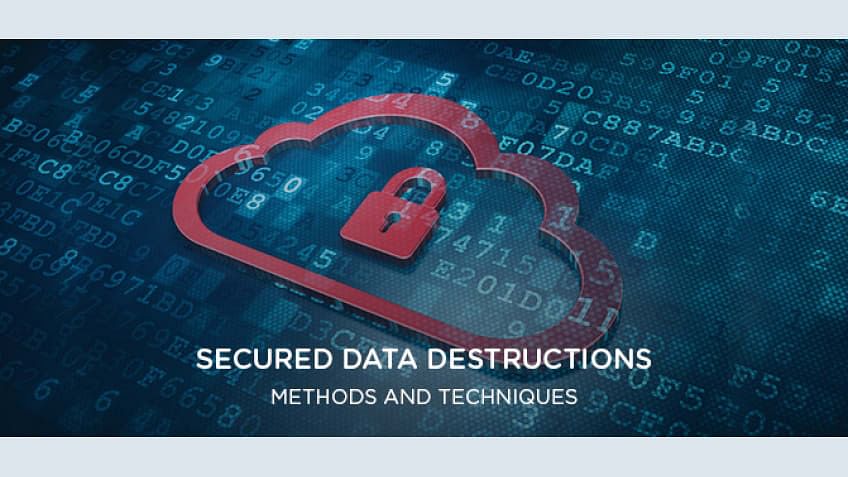The Impact of Effective Data Destruction on Cyber Security Risk Management
The Impact of Effective Data Destruction on Cyber Security Risk Management
Blog Article
Discovering the Importance of Data Damage in the Context of Computer Protection Providers and Protecting Confidential Information
In an age where information breaches are progressively usual, the significance of effective information devastation can not be overstated. Organizations must embrace rigid steps to guarantee that delicate details is not only secured during its lifecycle however additionally decisively eliminated when no longer essential. The techniques employed for data obliteration, coupled with conformity to lawful criteria, play a crucial function in keeping discretion and trust. Nonetheless, the ramifications of these practices extend beyond mere compliance, affecting a firm's track record and functional stability in the digital marketplace. What strategies can companies apply to enhance their data devastation procedures?
Recognizing Information Devastation
Data devastation is a crucial part of computer safety that entails the irreversible removal of data from storage space tools to stop unauthorized gain access to and potential information violations. In a progressively electronic landscape, companies deal with increased dangers connected with delicate information being poorly accessed or made use of. Effective information damage safeguards against these hazards, making sure that personal dataâEUR" such as customer details, intellectual building, and financial recordsâEUR" can not be recuperated after disposal.
Comprehending the importance of information damage extends beyond plain conformity with governing and lawful structures; it is essential for keeping business honesty and trust. When data is poorly managed or improperly destroyed, the repercussions can be severe, including financial loss, reputational damage, and legal obligations.

Techniques of Information Elimination

One prevalent approach is data cleaning, which involves overwriting existing information with random patterns multiple times. This method makes the initial data irretrievable, making it a prominent selection for companies seeking to shield secret information.
An additional approach is degaussing, which utilizes a powerful electromagnetic field to disrupt the magnetic domains on storage space tools, properly removing the data. This method is specifically reliable for magnetic media however is not applicable to solid-state drives.
Physical destruction is another durable approach, crushing or including the shredding of storage space devices. This method warranties that information recovery is practically impossible, making it ideal for very delicate details.
Lastly, encryption can work as a corresponding technique to information eradication. By securing information prior to removal, companies can add an extra layer of security, guaranteeing that even if residues are recouped, they stay unattainable without the decryption trick. Each approach needs to be selected based on the level of information sensitivity and the specific security demands of the company.
Legal Conformity and Data Security
Organizations should navigate a complicated landscape of lawful demands associated with data safety and security, especially after implementing methods of data eradication. Numerous guidelines, such as the General Information Defense Guideline (GDPR) and the Medical Insurance Portability and Liability Act (HIPAA), enforce rigorous standards on exactly how organizations have to get rid of and deal with of delicate data. Failure to abide by these guidelines can cause substantial lawful effects, including considerable fines and reputational damages.
Information damage procedures have to be thoroughly recorded to demonstrate compliance with suitable laws and standards. This paperwork not just acts as evidence of adherence to lawful responsibilities yet also illustrates a dedication to safeguarding delicate details. Organizations must additionally develop clear plans concerning information retention and destruction timelines, making sure that information is not learn the facts here now held longer than essential.

Furthermore, routine audits and evaluations of data devastation techniques are vital to preserve compliance and adapt to evolving legal structures (data destruction). By proactively dealing with legal needs, companies can reduce risks associated with data violations and show redirected here their dedication to data security. Ultimately, focusing on lawful conformity in information devastation procedures is not simply a regulatory responsibility, however a basic facet of a durable data safety strategy
Effect On Company Reputation
The track record of a service can be dramatically influenced by its method to data destruction and administration. In today's electronic landscape, where information violations can happen at any type of minute, the failure to appropriately dispose of delicate information can bring about extreme repercussions. Organizations that inadequately handle information devastation risk revealing personal consumer information, which not only breaches privacy regulations but likewise erodes trust among customers and stakeholders.
A tarnished credibility can lead to lowered client commitment, as customers come to be reluctant to engage with an organization that has shown negligence in protecting their data. Additionally, adverse promotion surrounding a data violation can have a long-term result, as potential customers may be hindered by the regarded absence of protection. This can result in a direct decline in profits and market share.
Additionally, services that prioritize information damage as part of their safety approach can boost their track record by showcasing their dedication to guarding sensitive information. By embracing rigorous information management techniques, organizations can not just minimize risks yet likewise place themselves as credible entities in their particular markets, consequently enhancing their general brand photo.

Best Practices for Secure Disposal
Implementing best methods for secure disposal of information is necessary for alleviating risks connected with data breaches and guaranteeing conformity with personal privacy laws. Organizations must adopt an extensive information disposal policy that outlines procedures for both digital and physical information damage.
For physical data storage space gadgets, such as disk drives, shredding or degaussing is advised to avoid data healing. In addition, companies must keep a chain of guardianship paperwork during the disposal index process, making sure accountability and traceability of disposed products.
For electronic data, making use of software program that sticks to sector requirements for information cleaning is vital. This software ought to overwrite existing information multiple times, making recovery virtually difficult. It is also essential to validate the effectiveness of the information devastation procedure with audits or third-party analyses.
Educating employees on protected disposal practices adds one more layer of safety and security, as human mistake can usually lead to information exposure. Consistently upgrading and assessing disposal plans guarantees placement with advancing laws and technological advancements. By applying these finest methods, organizations can significantly reduce the danger of unauthorized data accessibility and boost their overall data protection method.
Conclusion
To conclude, data devastation is a basic facet of computer safety and security solutions that ensures the protection of secret information from unauthorized access. Carrying out efficient techniques of information elimination, sticking to legal compliance, and recognizing the impact on service track record are important components of a thorough information safety and security technique. By taking on finest methods for safe and secure disposal, companies can cultivate count on with clients and protect delicate information, ultimately adding to a more safe and secure digital landscape.
In a period where information violations are progressively common, the significance of efficient information destruction can not be overemphasized.Data damage is a critical component of computer protection that entails the long-term removal of data from storage space gadgets to stop unapproved gain access to and prospective data breaches. Organizations ought to likewise develop clear policies pertaining to information retention and damage timelines, making certain that information is not held longer than needed.
By proactively attending to lawful needs, organizations can alleviate threats linked with information violations and show their commitment to data protection (data destruction). Eventually, prioritizing legal compliance in data damage processes is not just a governing commitment, yet a fundamental aspect of a durable information safety technique
Report this page